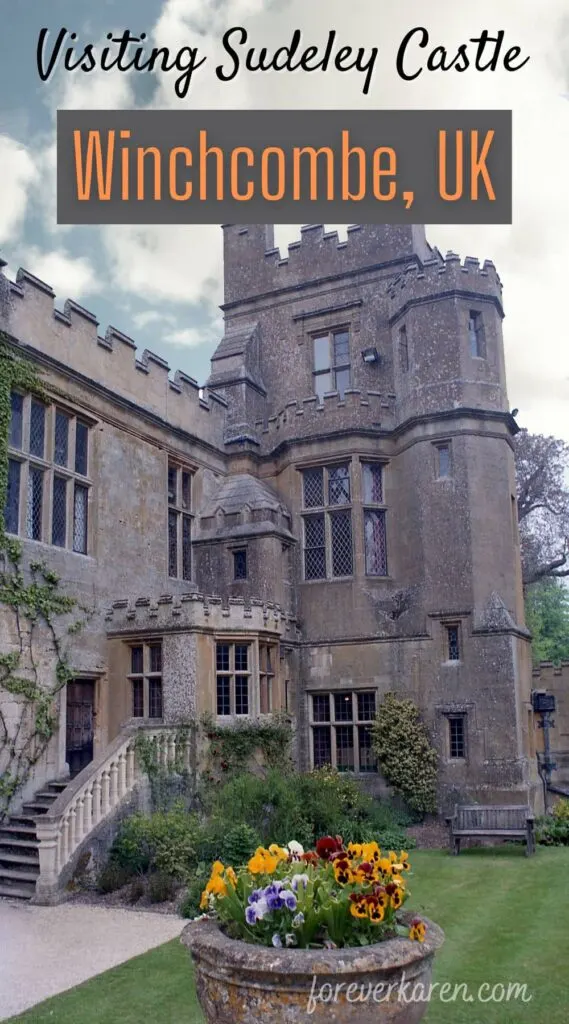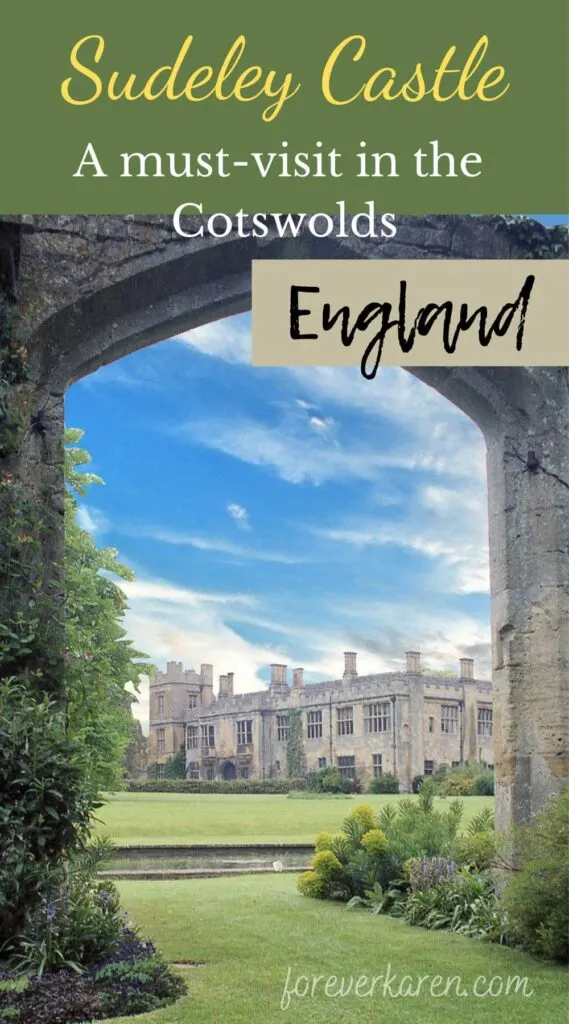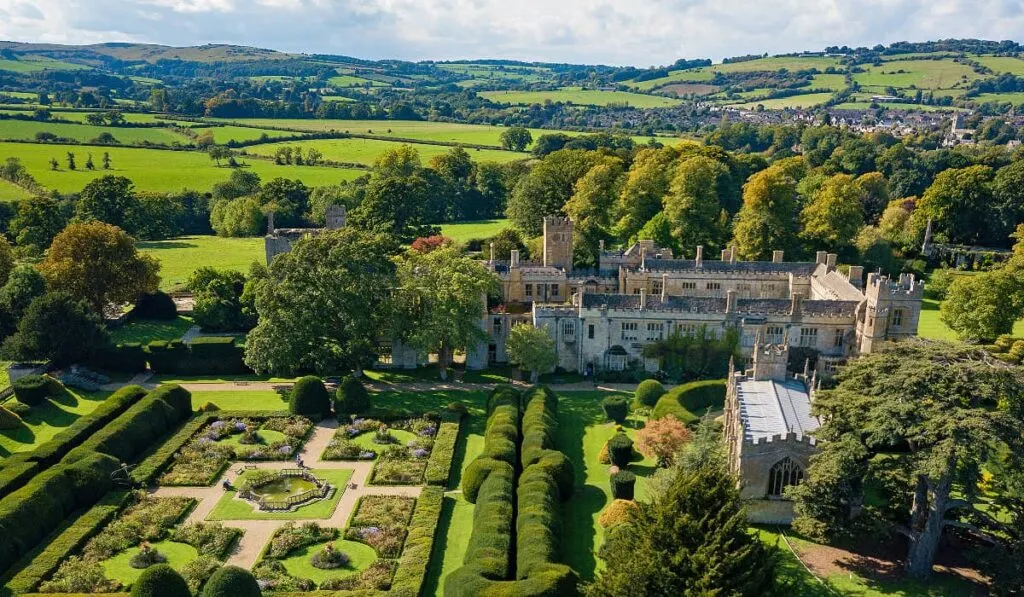
Nestled in the Cotswolds northeast of the famous Gloucester Cathedral, I visited the historic Sudeley Castle while staying in Cirencester. Each summer, Gloucestershire attracts tourists to the picturesque Cotswolds villages to see its honey-colored stone buildings and charming villages that exude so much character.
There can be no better example than Painswick, a lovely wool mill town with a churchyard resembling a garden from Alice in Wonderland.
Like most castle attractions, the estate opened its door to pay for its expensive upkeep and continuous renovations. Compared to other must-visit castles in England, Sudeley has a troubled past, having changed ownership numerous times and was once left in ruins.
However, now restored, the estate boasts the notoriety of being the only private British home to have a queen buried there. So, don’t miss this hidden gem because its images and history resemble those from a historical romance novel.
Currently, Lady Ashcombe and her family reside within the stone walls, but visitors can tour the west wing and parts of the east wing. The inside tour consists of two parts, the exhibition rooms detailing the history and the private rooms used by the family.
The entrance fee includes admission to ten incredible gardens that ooze with romance. It’s here that I admired the ruins of the Banqueting Hall and Tithe Barn.
Where Is Sudeley Castle?
- Location: Winchcombe, Gloucestershire | Open: Daily 10 am to 5 pm from February to October
Located near the town of Winchcombe, visitors can access the estate from the B4632. If you’re traveling on the M5, it’s 10 miles from junction 9.
When staying in London and have no vehicle, the nearest train station is Cheltenham Spa. From there, travelers can travel by bus or taxi to the castle.
The castle has a free visitor car lot for those that drive. Admission to Sudeley costs GBP 19.50 for adults, GBP 8.75 for children 3 to 15 years, and toddlers under three are free.
Families can also purchase a family pass for GBP 48.00. The estate opens from February to the end of October, but the dates may vary each year.
Do note that the castle exhibition and interior rooms are not wheelchair accessible.
Sudeley Castle History
Records show that in 1442, Ralph Boteler Baron of Sudeley built the initial castle, although there may have been another structure on the site previously. Like most great British castles, Sudeley holds an exciting history of occupants, usage, and tragedy.

In fact, when you visit Sudeley, know that you walk in the same footsteps as Anne Boleyn, Queen Elizabeth I, King Charles I, and Lady Jane Grey.
In 1469, the government took the castle for use as a military stronghold and gave it to the Duke of Gloucester. He later became King Richard III of England.
While living at Sudeley Castle, he built the Banqueting Hall, now in ruins embellished by beautiful vines that climb the crumbling walls.
After Richard III’s death, the fortress passed to Henry VIII, and during his reign, some of his wives resided at Sudeley. After his sixth’s wife’s demise, the castle estate became a resting place for Katherine Parr’s remains.
From that time onwards, the castle changed hands and was even sold, later becoming a rental. Can you imagine living at such a prestigious address?
The structure fell into disrepair with a revolving door of tenants, and Sudeley Castle’s fate seemed uncertain. Unfortunately, visitors to England can find countless numbers of crumbling castles with similar neglectful stories.
But fortunately for the Cotswold castle, wealthy glove manufacturers William and John Dent stepped in to save the medieval structure. After the purchase in the 1830s, the Dent brothers and their descendants carefully restored and maintained the estate returning it to its former glory.
During the restoration, they decided to leave some parts of the castle in ruins, giving it the charming disposition seen today.
Of the 1,200 acres, the gardens take up 15 acres, which have evolved throughout the years. The ten distinctive gardens are a horticultural paradise, with the Queen’s Garden taking center stage.
What To Expect During A Visit
Approaching the castle, its fairy-tale persona engulfed me, and it reminded me of another fantastic property, Leeds Castle. Admiring the estate, I don’t know what was more striking; the honey-colored Cotswold stone or the incredible beauty of its surroundings.
Currently a residential home, my visit to the estate included a few rooms over three floors and an indoor exhibit with found treasures.
The exhibition, called the ‘Royal Sudeley 1,000, Trials, Triumphs and Treasures,’ displays the castle’s history and features an incredible collection of fragile textiles assembled by Emma Dent. It’s important to tour the exhibit to dive deep into Sudeley’s past.
But the majority of my visit was outside, touring the many award-winning gardens and admiring the picturesque ruins of the Banqueting Hall, which I imagined was once an impressive structure.
I was surprised to learn that the grounds were used as a POW camp to house Italian and German soldiers during World War II. Inside, the stone walls sheltered irreplaceable artwork from the Tate Gallery in London during the Blitz.
The Castle Tour
Touring the library, I marveled at the impressive 16th-century tapestry hanging opposite the stone fireplace. The collection of rare books, rich paneling, and antiques add to the atmosphere of the intimate space.
Admission to the castle includes two bedrooms. The most impressive room, the Chandos bedroom, contains sumptuous furnishings and a lovely four-poster bed once owned by King Charles I.
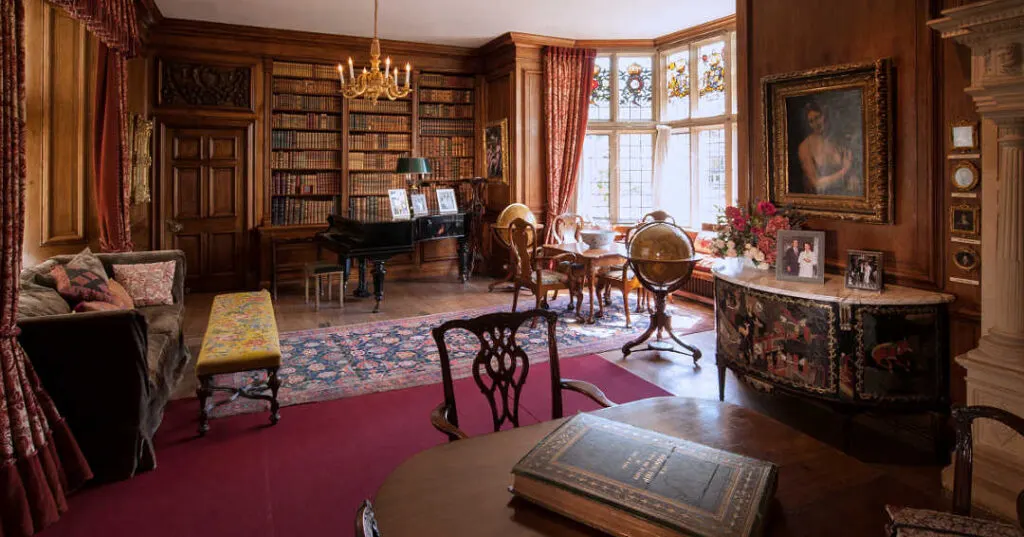
The west wing houses Katherine Parr’s anterooms, some of the oldest rooms in the castle. One room has a beautiful plaster ceiling, and the other, the queen’s private privy covered in red velvet.
The room’s stained-glass window overlooks St. Mary’s Church. A fitting perspective, considering it’s Katherine’s final resting place.

My favorite room was the drawing room because it had the homiest feeling with comfortable furnishings. The family had removed the previous wood paneling revealing Cotswold stone walls, which adds to the warmth of the space.
A large rendition of Charles II Coat of Arms hangs over the stone fireplace. On display throughout the castle are beautiful artworks by Turner, Rubens, and Van Dyke.
The exhibit section features items about the castle’s history. Of interest are items belonging to Katherine Parr, such as her prayer book, love letters, and a lock of her hair.
Another rare object, the ‘Bohun Book of Hours,’ is one of six known copies. Its manuscripts are beautifully written in exquisite calligraphy and embellished with colorful ornamentation.
While I found the castle less palatial than other British castles I’d seen, this didn’t detract from its beauty. In fact, knowing the castle was used and loved made it all the more appealing.
Sudeley Castle Gardens
Outside of the castle walls, I found the gardens simply stunning with their contrasting designs. Some of the designs can be attributed to the former owner, Emma Dent. From one to the next, I admired each one, their layouts inspired by the castle’s history.
The pinnacle of the grounds is the Queens’ Garden, so picturesque with its variety of roses and encompassed by yew trees. This centerpiece garden’s inspiration came from the four queens; Elizabeth I, Katherine Parr, Lady Jane Grey, and Anne Boleyn.
In another area, the Knot Garden reminded me of Blenheim Palace with its geometric layout, only on a smaller scale. The courtyard’s garden design came from Elizabeth I’s dress, worn in a portrait displayed in the castle.
Two ruins adorn the Sudeley Castle estate and add a touch of romanticism to the flora. The Tithe Barn, seen when approaching the castle from the car park, has a serene carp pond fronting it.
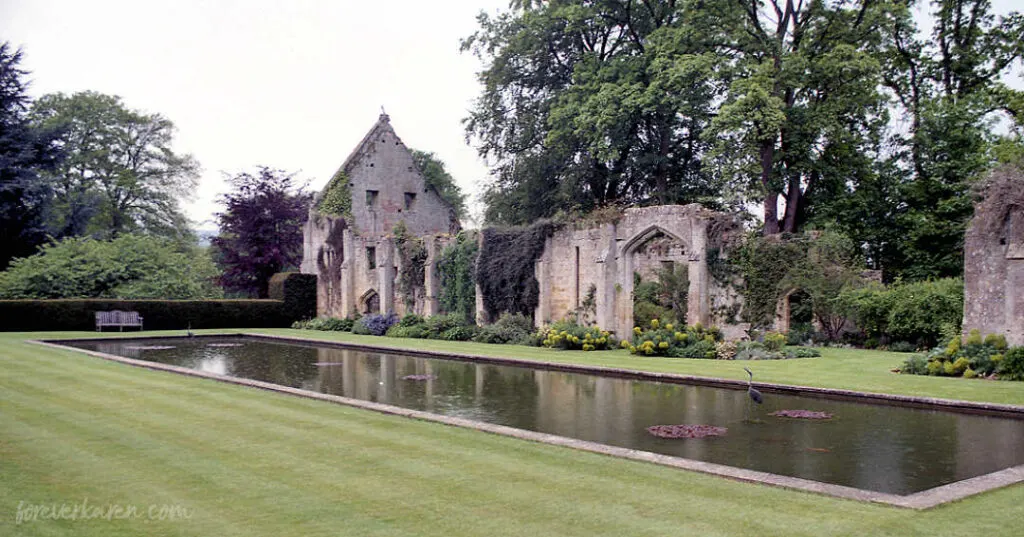
By far, the most striking area is the Ruins Garden which contains the Tudor Banqueting Hall. Once part of the medieval castle, the Dent family chose not to restore it and let it age gracefully.
Within some of the remaining walls, the gothic windows allow glimpses into the surrounding gardens. Throughout the years, trellising clematis vines and other climbing flora have harmonized with the structure, adding softness and enchantment.

The East Garden contains a trellised walkway that leads to the pheasantry. Although pheasants were common in Britain’s countryside, some species are almost extinct. With the help of the World Pheasant Association, the estate has successfully bred some rare breeds.
During my first visit to Sudeley Gardens, I saw two rare white peacocks wandering the grounds. Without any color pigment, I thought they were more exquisite than regular peacocks. On my last visit, these were gone.
St. Mary’s Church
Another garden, the ‘Queen’s Walk,’ leads from the castle to the chapel. Once a covered gallery providing private access to the church, it’s now a trellised open walkway.
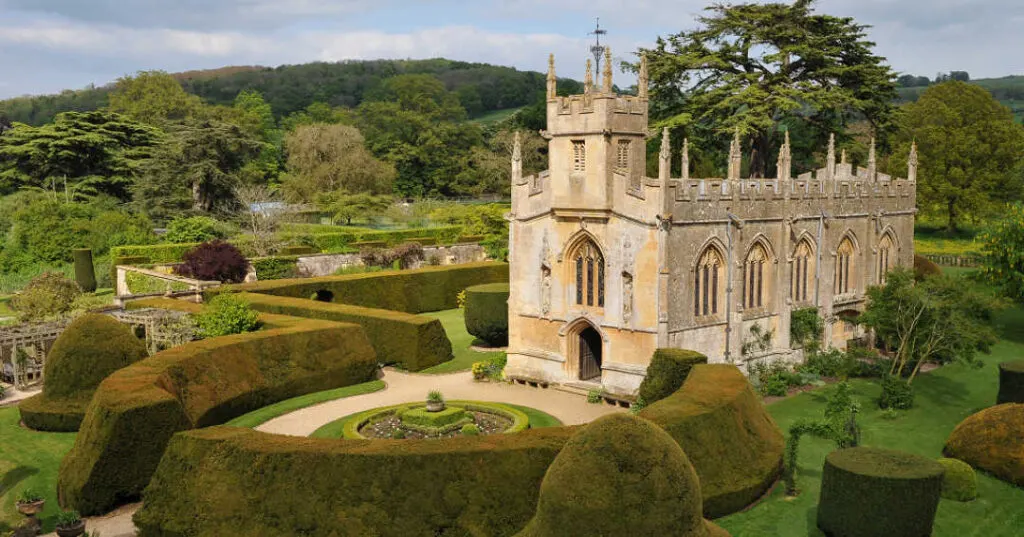
Belonging to the parish of Winchcombe, St. Mary’s Church provides a peaceful resting place for Henry VIII’s sixth wife, Katherine Parr.
Katherine Parr survived the marriage without a divorce or beheading and became a widow after King Henry’s death. She later married Thomas Seymour but died of complications from childbirth.
Sadly, her coffin had been opened multiple times after her death. But, in the mid-1800s, she finally received an effigy fit for a queen. At that time, architect George Gilbert Scott was in charge of the Norman chapel restoration.
As part of the work, he designed a canopied marble tomb for Katherine’s remains, carved by John Birnie Philip.
So, hundreds of years after her death, Katherine Parr has a tranquil resting place in a 15th-century church surrounded by clematis, tulips, vines, and roses. Although, some say her ghost still haunts the castle.
Sudeley Castle Cottages
To explore the Cotswolds further, consider staying on the Sudeley estate. While you can’t stay in the castle, the estate owns and rents out beautiful cottages, all within a short walk of Winchcombe.

The Sudeley Castle stone cottages, all equipped with modern amenities, have historical names. So, choose between Lady Jane Grey, Princess Elizabeth, Emma Dent, or the Castle Gatehouse.
Popular amongst visitors, these cottages are often booked months in advance. While staying at one of these charming cottages, you’ll enjoy free admission to the castle.
Final Thoughts
While the castle provides a great day outing for adults, it’s an ideal family venue too. The children can enjoy admiring the exhibits inside the castle and outside; the adventure playground features a large fort.
Children of all ages can pretend to defend their kingdom by climbing the towers, crossing bridges, and peering through castle windows.
Even though a family resides in the castle, individuals can rent space for events and parties. Imagine feeling like a princess as you say your “I dos” at one of the estate’s venues.
With so many picturesque places to take wedding photos, the castle makes for a fairy-tale wedding if you have the right budget.
Should you want to visit another castle home, consider a trip to Arundel Castle in West Sussex. Its gardens are magnificent, and while the Duke and Duchess of Norfolk reside in the castle, visitors can tour a considerable part of it.
Happy travels ~ Karen
